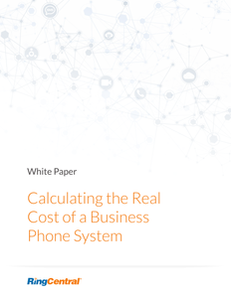The biggest problems with on-premise PBX systems revolve around manageability, flexibility, and cost. When replacing a legacy system, the basic cost of getting a new system up and running may be the most conspicuous concern. But it pays to look beyond the obvious hard costs of a new PBX / IP PBX and phones.
This analysis reveals the many hidden costs of an on-premise phone system, which can total more than the large initial capital expense of the basic hardware. Things to look for when assessing total cost of ownership include:
- PBX upgrades, licensing, and maintenance, including the need for trained resources
- Telecom charges for PRIs, T1s, local long distance, and 800 charges
- Standalone services such as eFax, audio conferencing, and web meetings
- Connecting locations with MPLS, PSTN, or other business exchange lines
This white paper also describes how a cloud phone system like RingCentral can eliminate many of these hard costs, and decrease the burdens and management complexity that challenge IT resources. In fact, for many companies, the cost savings can amount to 30% to 70% or even higher compared with an on-premise PBX system.

